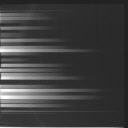
[1050 x 1050 - JPEG: 90 Kb].
La prima immagine ottenuta in Multi Object Spectrocopy (MOS) da d.o.lo.res

|
Descrizione fotografia [1050 x 1050 - JPEG: 90 Kb]. |
La prima immagine ottenuta in Multi Object Spectrocopy (MOS) da d.o.lo.res |
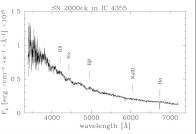
|
Descrizione fotografia [High-Res 3000 x 2246 - JPEG: 3.6 Mb]. |
La supernova SN 2000ck in IC 4355. L'immagine è ottenuta con un esposizione di 30 secondi (filtro R). |
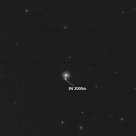
|
Descrizione fotografia [High-Res 3000 x 2246 - JPEG: 3.6 Mb]. |
"A fully reduced CCD spectrum (range 333.3-722.3 nm, resolution 1
nm), obtained on May 31.03 UT with the TNG reflector (+ D.o.lo.res
spectrograph), tentatively shows SN 2000ck (cf. IAUC 7431) to be a
type-II supernova near maximum light. The spectrum is dominated by
a very blue continuum (T_bb about 17 000 K), upon which we identify
(even if faint) H-delta, H-gamma, and H-beta lines with relatively
narrow P-Cyg profiles (from which we derive an expansion velocity
of about 6200 km/s). There is no sign of a broad H-alpha feature.
From weak interstellar lines due to the Na I D absorption feature
(EW about 0.12 nm) seen at about 605.3 nm, we derive a parent-galaxy
recession velocity of about 8150 km/s."
S. Jha, P. Challis, and R. Kirshner, Harvard-Smithsonian
Center for Astrophysics; and P. Garnavich, University of Notre Dame,
write: "Spectra of SN 2000ck, taken by P. Berlind and Garnavich on
May 27.4, 28.3, 29.2, 30.2, and 31.3 UT with the Whipple
Observatory 1.5-m telescope (+ FAST spectrograph), show it to be an
unusual type-II supernova at an early epoch. The spectra exhibit a
blue continuum with narrow emission lines of [O II], H-gamma,
H-beta, [O III], [O I], [N II], H-alpha, and [S II] from a
superimposed H II region at the recession velocity of IC 4355 (8048
km/s in the NASA/IPAC Extragalactic Database). From the supernova
itself, there are broad but very weak absorption features of H-beta
(expansion velocity 6700 km/s) and He I (rest 587.6 nm, expansion
velocity 5300 km/s) that have developed only very slowly. Strong
interstellar Na I absorption (with equivalent width 0.1 nm) at the
host-galaxy redshift implies significant extinction by dust."
A. V. Filippenko and A. C. Coil, University of California at
Berkeley, communicate: "A CCD spectrum (range 320-1000 nm) of SN
2000ck obtained on May 31 UT with the Shane 3-m reflector at Lick
Observatory exhibits a blue, nearly featureless continuum. It
resembles the spectrum of the peculiar type-II supernova 1993J at
very early times (Filippenko 1997, ARAA 35, 309), but the type-II
classification is not yet certain."
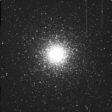 L'ammasso globulare NGC 5024 |
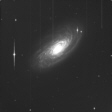 La galassia a spirale NGC 4501 |
| Dolores e la spettroscopia |
| Dolores: lo strumento |